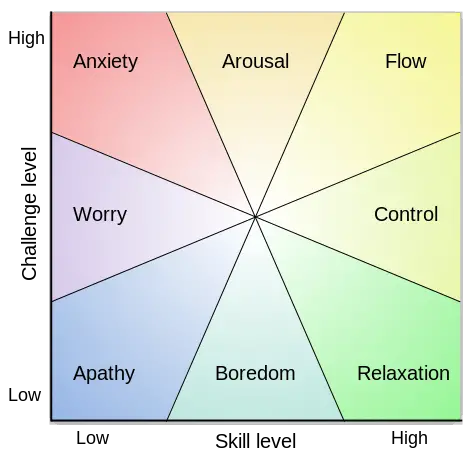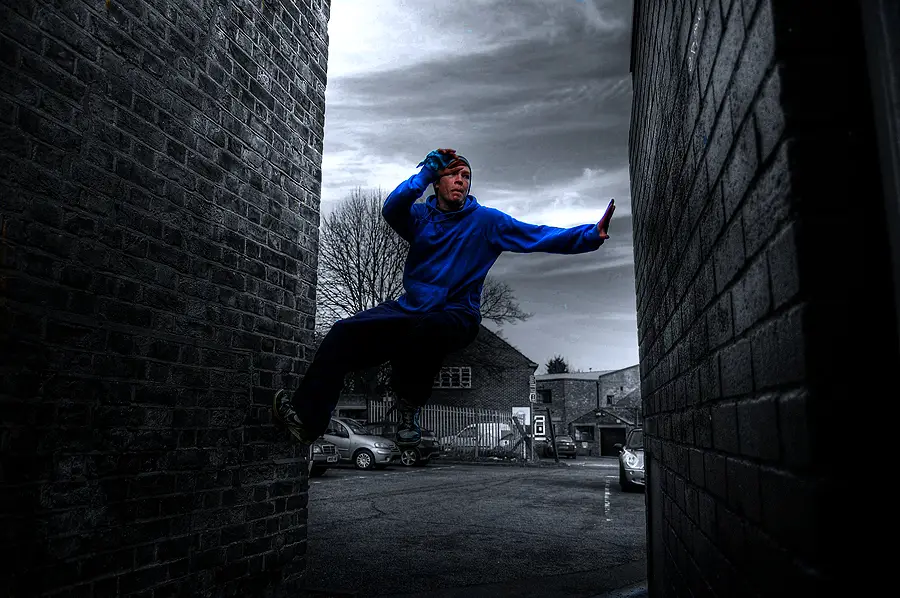Are you tortured by your fitness regime? You’re not alone. The prevailing theory on what fitness is, is torture. Just look at The Biggest Loser or any As-Seen-On-TV DVD program rife with sweaty athletes and endless panting.
What do these images do to your head? They plant the impression that absolute pain is necessary to get lean or to be healthy (how nebulous) as a consequence. Fitness isn’t that, and thinking that way will sabotage your progress.
The Flow Factor
Aside from diet, training, and rest, the biggest contributor to a positive workout habit is finding flow. Flow is a defined psychological phenomenon referring to a feeling where you are “fully immersed in a feeling of energized focus, full involvement, and enjoyment in the process of the activity”. That is, your entire mind is fully engaged on completing a single task. Somewhere between effortlessness (which creates boredom and apathy) and extreme difficulty (which creates anxiety and avoidance), we find this state of flow. Athletes know this area as “the zone”, where your body and mind perform in concert and make the impossible seem possible.
This state of mind is addicting. What makes flow so powerful is that it intrinsically motivates you as says Jamie Wheal, Executive Director of the Flow Genome Project, notes. it isn’t a task you feel you “must do”. Instead, it becomes a pursuit of the feeling, of overcoming a challenge that requires your very best efforts.
“Once an experience produces the state, we will go to extraordinary lengths to get more of it.”
-Jamie Wheal, Executive Director, Flow Genome Project
Flow is what fuels those long focused work hours (sometimes over 24 hours straight) at coding houses. Flow is what engrosses musicians in the symphony of their own music. Flow is what creates trainees that generate a dedication to fitness for life, setting the stage for healthy body and mind for the rest of their lives. Yes, finding flow is extremely important for fitness aspirants because it allows you to tap into intrinsic passion, like
The Anatomy of Flow
So what exact is flow? There’s two ways to look at it: mentally and neurochemically.
Let’s start with the mental aspect of flow. Somewhere between effortlessness and extreme difficulty, you start to get hooked on the process, dedicating your focus and concentration, willingly and without distraction, to the pursuit of a single task. Your mind is hyperfocused and your senses are opened. Psychology Professor Mihaly Csikszentmihalyi’s Flow Model describes this visually:

See flow in the top right corner? There are two conditions needed to experience flow: High Challenge, and High Skill. Now don’t fret, if you’re reading this, you likely don’t have that level of “skill” in fitness, which I describe as comprehension of the feelings associated with working out (“feeling the burn”, “the pump”, “muscular vs. skeletal pain”, etc). However, these feedback mechanisms are quickly learned by the body. I find that people I train with can pick up these cues within 2 weeks. After that point, flow can be found, and they start to indulge in the workout process, hyperfocused and hooked on overcoming all new progression challenges.
Neurochemically, what’s happening in your brain is a cocktail of neurotransmitters are bouncing about. There are 5 identified that help create the experience and improve performance: norepinephrine, dopamine, endorphins, anandamide, and serotonin. Alone, they have powerful effects (smoking marijuana, for example, primarily affects dopamine and serotonin levels), but together, they create this hyperfocused, hyperproductive sensation.
Norepinephrine and dopamine modify your focus and shuts out the noise. Endorphins block pain. Anandamide sparks insight by increasing lateral thinking prowess. Serotonin creates that feel-good feeling that leaves you wanting more. All 5 together create the experience of flow by modifying your “normal” motivational, learning, and creativity levels.
So now you know mentally and chemically what Flow is. The real question is: are you in it?
Are You Thinking in Flow?
Are you finding flow in your workouts? If you have any of these problems, you are not finding flow:
- You dread working out
- You don’t feel happy that you worked out
- You are thinking of other things during the performance of working out (for example: while you’re in the middle of an exercise, you’re thinking of something other than what rep you’re on, or how the exercise feels)
- You’re bored during your workout
- You just want your workout done with
Alternatively, this is how your workouts feel when you are finding flow:
- You look forward to working out, even on dedicated rest days
- You feel energized, happy, and fulfilled after you complete a workout
- You don’t think of anything other than the workout, while working out. Not about your kids, your investments, your budgets, your side projects… all you focus on is the glorious feeling of movement
- You are engaged with your workout, consciously feeling every contraction and sensation in your body
How Can You Find Flow?
So here’s the tricky part. How does one find flow? The cues that I find are most helpful during the performance of exercise are:
- Training like a curious monkey. Notice every sensation of your muscle moving and every breath. Don’t tune out your senses. This is important. You need to know the feeling of your body working if you want to achieve flow. Indulge in your body’s sensations.
- Pretending you’re an action hero(ine). This cue is about the Pursuer’s Mindset. You’re lifting, climbing, and sprinting your way to save people. You have a goal and cannot fail. Workout like your life – or the lives of everyone you care about – depend on it. I’ll repeat, you CANNOT fail.
- Acting vigorous. Feel like your energy is bursting through at the seams when you’re on that pull-up bar. Treat every single pull-up like an exercise in dominance. Conquer it. You own it. It does not own you. Train a little dirty.
- Reflect and recover. During rest sets, you don’t need to feel all pumped up. Your mind needs to come back down to Earth and allow you to recover for your next set, lest you become anxious from all the vigorous activity. A little rest lets your body catch up to your mind, so you can conquer your next set.
… Whew, just typing that up got me excited.
Finding flow and building a fitness habit is why I built GainTrain’s Workout System. I had in mind a way to make anyone an expert in bodyweight strength training by offering progressions and training the “feeling” associated with high skill. Instead of a series of disjointed workouts, GainTrain’s System teaches you how to manage your own workout program and understand the feeling of movement. Though in its infancy, I will be adding more material about the elements of successful programs and the mindset of those who see results.
Do you have any seriously cool experiences with flow, workout related or otherwise? What challenges have you faced trying to get into the zone? Let me know in the comments below.
Strive to be strong.
-Aaron
